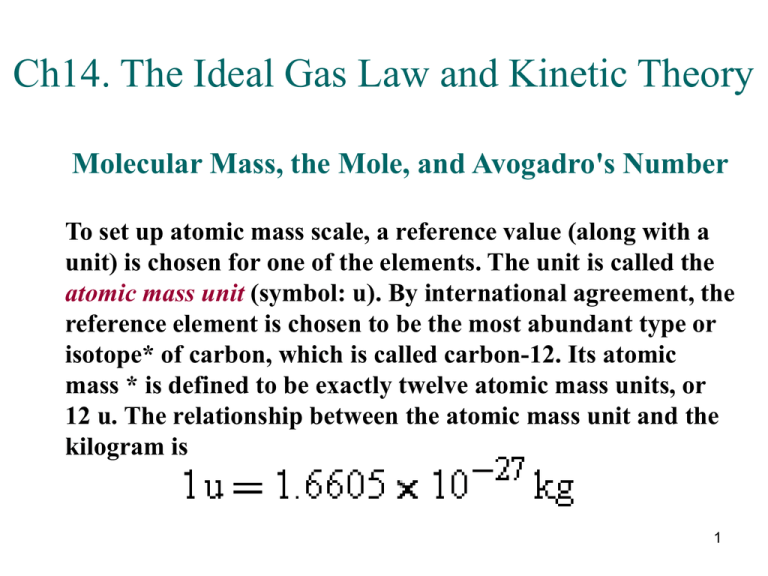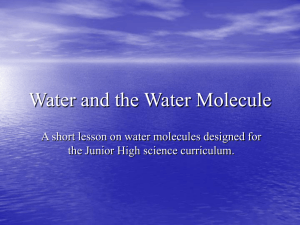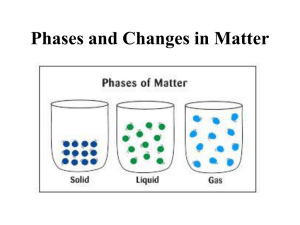Ch14 The Ideal Gas Law and Kinetic Theory
advertisement

Ch14. The Ideal Gas Law and Kinetic Theory Molecular Mass, the Mole, and Avogadro's Number To set up atomic mass scale, a reference value (along with a unit) is chosen for one of the elements. The unit is called the atomic mass unit (symbol: u). By international agreement, the reference element is chosen to be the most abundant type or isotope* of carbon, which is called carbon-12. Its atomic mass * is defined to be exactly twelve atomic mass units, or 12 u. The relationship between the atomic mass unit and the kilogram is 1 A portion of the periodic table showing the atomic number and atomic mass of each element. In the periodic table it is customary to omit the symbol “u” denoting the atomic mass unit. 2 The molecular mass of a molecule is the sum of the atomic masses of its atoms. Macroscopic amounts of materials contain large numbers of atoms or molecules. Even in a small volume of gas, 1 cm3, for example, the number is enormous. It is convenient to express such large numbers in terms of a single unit, the gram-mole, or simply the mole (symbol: mol). One gram-mole of a substance contains as many particles (atoms or molecules) as there are atoms in 12 grams of the isotope carbon-12. 12 grams of carbon-12 contain 6.022 × 1023 atoms. The number of atoms per mole is known as Avogadro’s number NA, after the Italian scientist Amedeo Avogadro (1776–1856): 3 4 The mass per mole (in g/mol) of a substance has the same numerical value as the atomic or molecular mass of the substance (in atomic mass units). 5 Example 1. The Hope Diamond and the Rosser Reeves Ruby The Hope diamond (44.5 carats), which is almost pure carbon. The Rosser Reeves ruby (138 carats), which is primarily aluminum oxide (Al2O3). One carat is equivalent to a mass of 0.200 g. Determine (a) the number of carbon atoms in the diamond and (b) the number of Al2O3 molecules in the ruby. (a) m = (44.5 carats)[(0.200 g)/(1 carat)] = 8.90 g 6 (b) m = (138 carats)[(0.200 g)/(1 carat)] = 27.6 g. . Calculations like those in part (a) reveal that the Rosser Reeves ruby contains 0.271 mol or 7 Check Your Understanding 1 A gas mixture contains equal masses of the monatomic gases argon (atomic mass = 39.948 u) and neon (atomic mass = 20.179 u). They are the only gases in the mixture. Of the total number of atoms, what percentage is neon? 0.664 8 The Ideal Gas Law An ideal gas is an idealized model for real gases that have sufficiently low densities. 9 The absolute pressure of an ideal gas is proportional to the number of molecules or, equivalently, to the number of moles n of the gas (P n). P nT/V. IDEAL GAS LAW The absolute pressure P of an ideal gas is directly proportional to the Kelvin temperature T and the number of moles n of the gas and is inversely proportional to the volume V of the gas: P = R(nT/V). In other words, where R is the universal gas constant and has the value of 8.31 J/(mol·K). 10 The constant term R/NA is referred to as Boltzmann’s constant, in honor of the Austrian physicist Ludwig Boltzmann (1844–1906), and is represented by the symbol k: 11 Example 2. Oxygen in the Lungs In the lungs, the respiratory membrane separates tiny sacs of air (absolute pressure = 1.00 × 105 Pa) from the blood in the capillaries. These sacs are called alveoli, and it is from them that oxygen enters the blood. The average radius of the alveoli is 0.125 mm, and the air inside contains 14% oxygen. Assuming that the air behaves as an ideal gas at body temperature (310 K), . find the number of oxygen molecules in one of the sacs. 12 One mole of an ideal gas occupies a volume of 22.4 liters at a temperature of 273 K (0 °C) and a pressure of one atmosphere (1.013 × 105 Pa). These conditions of temperature and pressure are known as standard temperature and pressure (STP). 13 Conceptual Example 3. Beer Bubbles on the Rise The next time you get a chance, watch the bubbles rise in a glass of beer. If you look carefully, you’ll see them grow in size as they move upward, often doubling in volume by the time they reach the surface. Why does a bubble grow as it ascends? The number of moles does increase as the bubble rises. Each bubble acts as a nucleation site for CO2 molecules, so as a bubble moves upward, it accumulates carbon dioxide from the surrounding beer and grows larger. 14 Boyle’s law A pressure-versus-volume plot for a gas at a constant temperature is called an isotherm. For an ideal gas, each isotherm is a plot of the equation P = nRT/V = constant/V. 15 Check Your Understanding 2 Consider equal masses of the three monatomic gases argon (atomic mass = 39.948 u), krypton (atomic mass = 83.80 u), and xenon (atomic mass = 131.29 u). The pressure and volume of each is the same. Which gas has the greatest and which the smallest temperature? Xenon has the greatest and argon the smallest temperature. 16 Example 4. Scuba Diving In scuba diving, a greater water pressure acts on a diver at greater depths. The air pressure inside the body cavities (e.g., lungs, sinuses) must be maintained at the same pressure as that of the surrounding water; otherwise they would collapse. A special valve automatically adjusts the pressure of the air breathed from a scuba tank to ensure that the air pressure equals the water pressure at all times. The scuba gear consists of a 0.0150-m3 tank filled with compressed air at an absolute pressure of 2.02 × 107 Pa. Assuming that air is consumed at a rate of 0.0300 m3 per minute and that the temperature is the same at all depths, determine how long the diver can stay under seawater at a depth of (a) 10.0 m and (b) 30.0 m. 17 (a) 18 (b) The calculation here is like that in part (a). Absolute water pressure is 4.02 × 105 Pa Vf = 0.754 m3 19 Frenchman Jacques Charles (1746–1823) discovered that at a constant pressure, the volume of a fixed mass (fixed number of moles) of a low-density gas is directly proportional to the Kelvin temperature (V T). Charles’ law 20 Kinetic Theory of Gases 21 THE DISTRIBUTION OF MOLECULAR SPEEDS 22 KINETIC THEORY The pressure that a gas exerts is caused by the collisions of its molecules with the walls of the container. 23 A gas particle is shown colliding elastically with the right wall of the container and rebounding from it. 24 25 26 Conceptual Example 5. Does a Single Particle Have a Temperature? Each particle in a gas has kinetic energy. Furthermore, the equation establishes the relationship between the average kinetic energy per particle and the temperature of an ideal gas. Is it valid, then, to conclude that a single particle has a temperature? A single gas particle does not have a temperature. 27 Check Your Understanding 3 The pressure of a monatomic ideal gas is doubled, while its volume is reduced by a factor of four. What is the ratio of the new rms speed of the atoms to the initial rms speed? vrms ,new vrms ,initial 0.707 28 Example 6. The Speed of Molecules in Air Air is primarily a mixture of nitrogen N2 (molecular mass = 28.0 u) and oxygen O2 (molecular mass = 32.0 u). Assume that each behaves as an ideal gas and determine the rms speeds of the nitrogen and oxygen molecules when the temperature of the air is 293 K. 29 30 THE INTERNAL ENERGY OF A MONATOMIC IDEAL GAS The internal energy of a substance is the sum of the various kinds of energy that the atoms or molecules of the substance possess. A monatomic ideal gas is composed of single atoms. These atoms are assumed to be so small that the mass is concentrated at a point, with the result that the moment of inertia I about the center of mass is negligible. 31 Diffusion The process in which molecules move from a region of higher concentration to one of lower concentration is called diffusion. The host medium, such as the air or water, is referred to as the solvent, while the diffusing substance, like the perfume molecules, is known as the solute. Relatively speaking, diffusion is a slow process, even in a gas. 32 Conceptual Example 7. Why Diffusion Is Relatively Slow In Example 6 we have seen that a gas molecule has a translational rms speed of hundreds of meters per second at room temperature. At such a speed, a molecule could travel across an ordinary room in just a fraction of a second. Yet, it often takes several seconds, and sometimes minutes, for the fragrance of a perfume to reach the other side of a room. Why does it take so long? 33 When a perfume molecule diffuses through air, it makes millions of collisions each second with air molecules. The speed and direction of motion change abruptly as a result of each collision. Between collisions, the perfume molecule moves in a straight line at a constant speed. Although a perfume molecule does move very fast between collisions, it wanders only slowly away from the bottle because of the zigzag path resulting from the collisions. It would take a long time for a molecule to diffuse in this manner across a room. Usually, however, convection currents are present and carry the fragrance across the room in a matter of seconds or minutes. 34 Using diffusion, a transdermal patch delivers a drug directly into the skin, where it enters blood vessels. The backing contains the drug within the reservoir, and the control membrane limits the rate of diffusion into the skin. Another way to control the diffusion is to adjust the concentration of the drug in the reservoir by dissolving it in a neutral material. 35 (a) Solute diffuses through the channel from the region of higher concentration to the region of lower concentration. (b) Heat is conducted along a bar whose ends are maintained at different temperatures. 36 FICK’S LAW OF DIFFUSION The mass m of solute that diffuses in a time t through a solvent contained in a channel of length L and crosssectional area A is where C is the concentration difference between the ends of the channel and D is the diffusion constant. SI Unit for the Diffusion Constant: m2/s 37 Example 8. Water Given Off by Plant Leaves 38 Large amounts of water can be given off by plants. It has been estimated, for instance, that a single sunflower plant can lose up to a pint of water a day during the growing season. Figure 14.17 shows a cross-sectional view of a leaf. Inside the leaf, water passes from the liquid phase to the vapor phase at the walls of the mesophyll cells. The water vapor then diffuses through the intercellular air spaces and eventually exits the leaf through small openings, called stomatal pores. The diffusion constant for water vapor in air is D = 2.4 × 10–5 m2/s. A stomatal pore has a cross-sectional area of about A = 8.0 × 10– 11 m2 and a length of about L = 2.5 × 10–5 m. The concentration of water vapor on the interior side of a pore is roughly C2 = 0.022 kg/m3, while that on the outside is approximately C1 = 0.011 kg/m3. Determine the mass of water vapor that passes through a stomatal pore in one hour. 39 40 Check Your Understanding 4 The same solute is diffusing through the same solvent in each case referred to in the table below, which gives the length and cross-sectional area of the diffusion channel. In each case, the concentration difference between the ends of the diffusion channel is the same. Rank the diffusion rates (in kg/s) in descending order (largest first). Length Cross-Sectional Area (a) ½L A (b) L ½A c, b, a (c) L 2A 41 Concepts & Calculations Example 9. The Ideal Gas Law and Springs 42 There are three identical chambers containing a piston and a spring whose spring constant is k = 5.8 × 104 N/m. The chamber in part a is completely evacuated, and the piston just touches its left end. In this position, the spring is unstrained. In part b of the drawing, 0.75 mol of ideal gas 1 is introduced into the chamber, and the spring compresses by x1 = 15 cm. In part c, 0.75 mol of ideal gas 2 is introduced into the chamber, and the spring compresses by x2 = 24 cm. Find the temperature of each gas. P = F/A F = kx P = kx/A 43 44 Concepts & Calculations Example 10. Hydrogen Atoms in Outer Space In outer space the density of matter is extremely low, about one atom per cm3. The matter is mainly hydrogen atoms (m = 1.67 × 10–27 kg) whose rms speed is 260 m/s. A cubical box, 2.0 m on a side, is placed in outer space, and the hydrogen atoms are allowed to enter. (a) What is the magnitude of the force that the atoms exert on one wall of the box? (b) Determine the pressure that the atoms exert. (c) Does outer space have a temperature, and, if so, what is it? 45 (a) 46 (b) (c) 47 Problem 22 REASONING AND SOLUTION If the pressure at the surface is P1 and the pressure at a depth h is P2, we have that P2 = P1 + gh. We also know that P1V1 = P2V2. Then, V1 P2 P1 gh gh 1 V2 P1 P1 P1 V1 (1.000 103 kg/m 3 )(9.80 m /s2 )(0.200 m ) 1 1.02 5 V2 (1.01 10 Pa) 48 Problem 41 REASONING AND SOLUTION a. As stated, the time required for the first solute molecule to 2 traverse a channel of length L is t L /(2D) . Therefore, for water vapor in air at 293 K, where the diffusion constant is D=2.4*10-5m2/s , the time t required for the first water molecule to travel L 0.010 m is L 0.01m t 2.1s 5 2 2D 2 2.4 10 m / s 2 2 49 b. If a water molecule were traveling at the translational rms speed for water, the time t it would take to travel the distance L 0.010 m would be given by t L / vrms, where, according to Equation 14.6 1 ( KE mv2rms ), v . Before we can use the last 2 rms 2KE/ m expression for the translation rms speed vrms, we must determine the mass m of a water molecule and the average translational kinetic energy KE Using the periodic table on the inside of the text’s back cover, we find that the molecular mass of a water molecule is 2(1.00794 u) 15.9994 u 18.0153 u Mass of two hydrogen atoms Mass of one oxygen atom 50 3 18.015310 kg / m ol 26 m 2 . 99 10 kg 23 1 6.02210 m ol The average translational kinetic energy of water molecules at 293 K is, according to Equation 14.6, KE 3 3 23 –23J 1 . 38 10 kT (1.3810 2 2 v rms 2KE m 21 – /J/K) K 293 K 6 . 07 10 293 K = 6.0710J –21 21 22 6.07 10 6.07 10 JJ 26 –26 2.99 10 kg 2.99 10 kg 637 m / s 637 m/s 51 Thus, the time t required for a water molecule to travel the distance at this speed is t L v rms 0.010 m 5 –5 11.6 10 ss . 6 10 637 m /s c. In part (a), when a water molecule diffuses through air, it makes millions of collisions each second with air molecules. The speed and direction changes abruptly as a result of each collision. Between collisions, the water molecules move in a straight line at constant speed. Although a water molecule does move very quickly between collisions, it wanders only very slowly in a zigzag path from one end of the channel to the other. In contrast, a water molecule traveling unobstructed at its translational rms speed [as in part (b)], will have a larger displacement over a much shorter time. Therefore, the answer to part (a) is much longer than the 52 answer to part (b) Problem 42 REASONING AND SOLUTION Fick’s law of diffusion gives 5 2 4 2 2 3 L D A C 4.2 10 m / s 4.0 10 m 3.5 10 kg/m 3 v 7.0 10 m/s 8 t m 8.4 10 kg 53 Problem 44 REASONING AND SOLUTION a. The average concentration is Cav = (1/2) (C1 + C2) = (1/2)C2 = m/V = m/(AL), so that C2 = 2m/(AL). Fick's law then becomes m = DAC2t/L = DA(2m/AL)t/L = 2Dmt/L2. Solving for t yields t L / 2D 2 b. Substituting into this expression yields t = (2.5 * 10–2 m)2/[2(1.0 * 10–5 m2/s)] = 31 s 54









